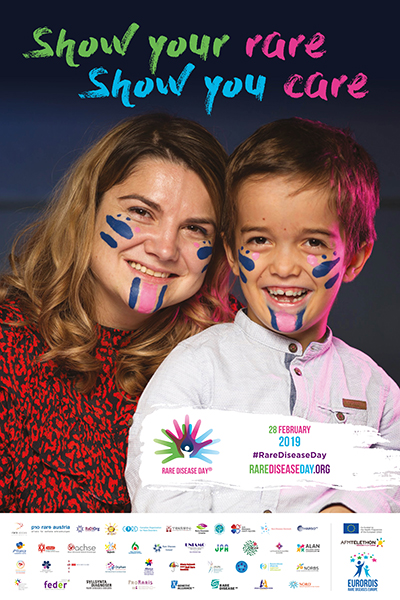Rare Disease Day – The Use of Technology
February 27, 2019

With Rare Disease Day coming up tomorrow, it is important to remember all the ways the medical field can help those who are suffering from rare illnesses. The collection and sharing of data, along with new advancements in technology are helping to break through barriers of rare diseases. Better patient care is ultimately a must, but we should remember to share medical information when possible in order to create more data to help solve these complex diseases.
Patient Registries and The Use of Technology to Help Rare Disease
For many physicians, data is the most powerful tool in helping patients fight illness. But for patients suffering from rare diseases, there may be limited information. That’s why many specialists turn to registries to help get a bigger picture for their patients. Since the diseases a patient may be dealing with are uncommon, looking at any other information from a similar patient can be life-changing. The way medical registries are used is shaping the way we care for those with rare diseases.
The Use of Patient Registries
Patient registries are defined as “an organized system that uses observational study methods to collect data (clinical and other) to evaluate specified outcomes for a population defined by a particular disease, condition or exposure, and that serves a predetermined scientific, clinical, or policy purpose.” This means that doctors are able to collect information about their patients, take that information, and transfer it to a database cloud system in order to make inferences on symptoms, diagnosis information, prognoses, and different treatments. This can help doctors treat rare diseases more accurately by taking what they already know from previous patients and vetting against the information found on a current patient. By finding ways they are similar and/or different, this will help them to better make decisions for the future.
A current example of this being done in the medical field is a team led by the Institute of Cancer Research London and the University of Edinburgh in Scotland through their AI technology called Revolver to discover mutations in cancerous cells. By feeding the software information on cancerous cells that started from mutations, they were able to pick out exact gene sequences that made the cell become cancerous. In order to get the information, however, patients had to agree to give their own personal cell medical data to be used for databases and further research. If this was not done, there would be no way for physicians or scientists to compare DNA sequences and pinpoint where things went wrong. Using technology like AI, physicians are better able to compare information with this smart software and in turn, solve medical mysteries for rare diseases.
Collecting Patient Information
There are many rules when it comes to collecting information from patients and using that data for medical studies. The Health Insurance Portability and Accountability Act (HIPAA) Privacy Rule permits health care providers to give patients the option to opt-in or opt-out to disclosing their medical information to other medical professionals for key purposes. Key purposes include, but are not limited to, treatment, payment, studies, and health care operations. The information then goes to the Electronic Health Information Exchange Organization (eHIE) for further use by medical professionals, who are able to tap into this network. If patients opt-out of sharing their information, this means their information is not legally allowed to be harvested for patient registry initiatives, and it means legal trouble for medical facilities if it is.
Mobile’s Contribution to Data Collection
Technology is extremely useful in helping to collect information about patients with rare diseases. For example, those with mesothelioma, an uncommon lung cancer, are hopeful that collecting more information from other cancers and other patients with this cancer, will help lead to better treatment and hopefully one day a cure. But how can technology help this? Telehealth technology is making strides to aid in collecting information from patients being treated over technology platforms. Also, they help to use information collected in their technology treatment.
By using the specified software, such as phone applications, doctors are able to transfer information about a patient, collect information on a patient, and do face-to-face appointments over video chat. Between patient and doctor, everything is logged and tracked helping to create more information that the patient can opt-in to share for further research. This can ultimately help create more data in the future.
However, there are downsides to this type of treatment. For those with a rare disease, it might be better to seek more traditional face-to-face appointments, due to the pressing nature of rarer illnesses. Also, anyone with a pressing illness should receive testing for diagnosis and prognosis in person with a healthcare professional. Apart from this, telehealth apps have a higher potential to violate HIPAA laws, which could turn many people away from telehealth treatments.
Better Care for Rare Disease Patients
One way technology is helpful is it provides those with rare disease more consistent care, by allowing patients to have better access on a more regular basis to physicians through mobile solutions, such as video communication. For those with a rare disease, there is usually a poorer prognosis and more consistent care can be a world of a difference for patients. Some patients cannot travel as frequently or as easy to get the treatment they need, so this can help them receive fast and accurate diagnoses and treatment without leaving the comfort of their home.
This helps patients with rare diseases maintain monitoring without sacrificing their independence as well. By using tablets, computers, and cellphones patients can stay in better contact with caregivers and healthcare providers. By using technology to communicate with doctors and caregivers, patients who need 24-hour care can keep some of their independence, rather than be with a caregiver 100 percent of the time.
By Rachel Lynch – Mesothelioma.com Mesothelioma Cancer Alliance